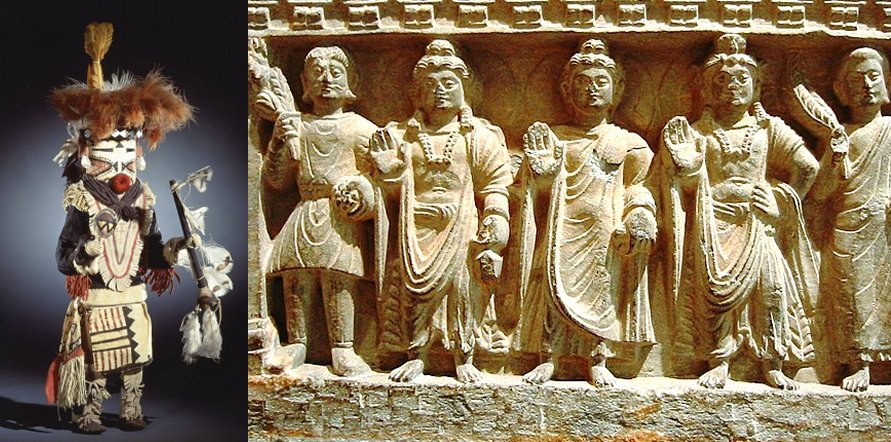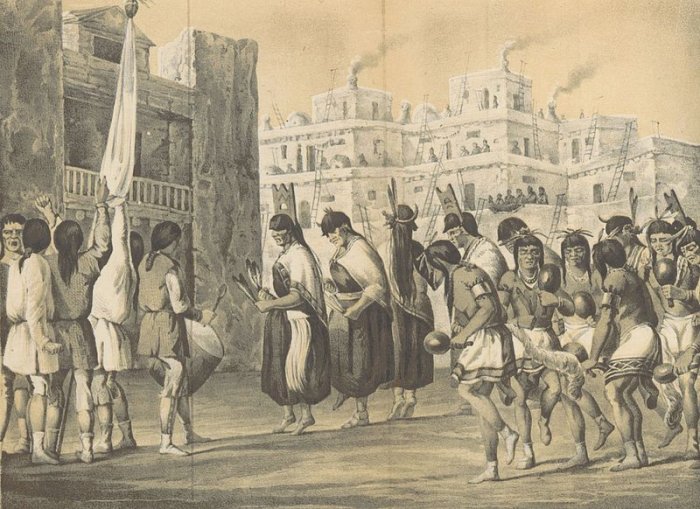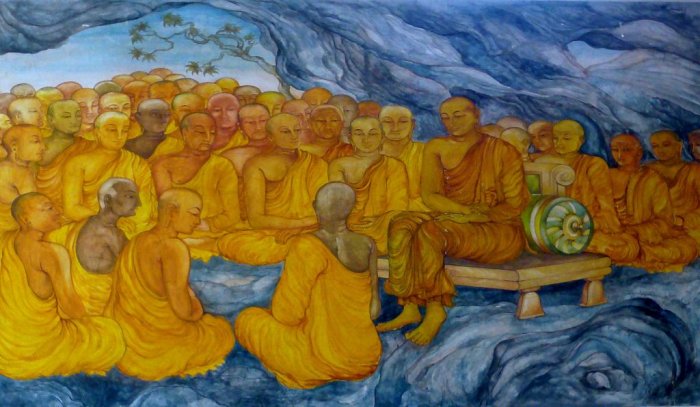Mysterious Zuni Indians And Japanese People May Be Related – Did Buddhist Monks Reach North America In 1350?
Ellen Lloyd - AncientPages.com - The Zuni Indians in New Mexico are unlike any other Native American tribe. Not only is their language, religion, and blood type surprisingly different from all other tribes, but according to a thought-provoking theory, the mysterious Zuni Indians may also have close ties with the people of Japan.
Most scientists think the Zuni Indians are different because they lived in isolation. According to linguists, the Zuni have maintained the integrity of their language for at least 7,000 years.
Left: She-we-na (Zuni Pueblo). Kachina doll (Paiyatemu), late 19th century. Brooklyn Museum - Right: An early Buddhist triad. 2nd-3rd century CE. Gandhara, Wikipedia
However, the Zuni do share many words from Keresan, Hopi, and Pima pertaining to religion and religious observances. However, Professor Nancy Davis from the University of Chicago has an alternative theory that she thinks explains the Zuni Indian's puzzling ancient history.
Professor Davis suggests the Zuni Indians came in close contact with Buddhist monks who migrated in the 14th Century from Japan to the west coast of what is now the American continent. In her book, The Zuni Enigma: A Native American People's Possible Japanese Connection, Professor Davis presents evidence supporting an ancient Japanese-Zuni connection.
Professor Davis has studied the Zuni Indians for decades and has made several visits to the Zuni pueblo. Her theory is unpopular among other scientists, but she points out that no one has so far managed to prove her wrong.
Image of Zuni Pueblo created during the U.S. Army Corps of Topographical Engineers' 1851 expedition to Arizona which was led by Captain Sitgreaves. Credit: British Library
She acknowledges there have been no DNA studies to confirm or refute her hypothesis. Still, she also points out striking similarities between these two cultures, such as blood-group characteristics. Blood Type B is frequent in East Asian populations but nearly absent in most Native Americans. Zuni Indians, on the other hand, have a high incidence of Type-B blood.
Zuni Indians And Japanese People Share Biological Links And Have Similar Mythology
The ancient Japanese- Zuni connection was born when Professor Davis one day came across a chart detailing the Chinese system of Yin Yang. Yin Yang symbol is widely recognized throughout the world. Still, the beginning and philosophy related to this ancient symbol originate in ancient China and the old beliefs of the Chinese people, who tried to understand the universe's workings. She discovered the Yin Yang symbol was remarkably similar to a chart on the Zuni religion.
 Next, she compared Zuni and Japanese languages and noticed a long list of nearly common words.
Next, she compared Zuni and Japanese languages and noticed a long list of nearly common words.
She searched for clues for more than 30 years and pieced together her ideas. Her research resulted in a theory that her colleagues dismissed. She collected evidence based on biological links through blood type, tooth shape, skull configuration, and a prominent kidney ailment in Zuni and the Japanese. Professor Davis also discovered that both cultures had a mythology that embraced ocean images.
Professor Davis explains that the Japanese social structure suffered during the 11th or 12th centuries because of repeated natural disasters, including a series of earthquakes. During this time, Japanese sailors began to leave the country in successive waves.
Buddhist Monks Reached America In 1350
One of the last of these waves of migration set sail around 1350.
Among the sailors were Buddhist monks searching for Itiwanna, the center of the universe. Based on her research, Professor Davis surmises that favorable currents landed the monks in California.
As the pilgrims moved eastward, they attracted Native Americans drawn to the notion of Itiwanna. Disparate clans united in a kind of search for Oz. In an area of what is now west-central New Mexico and east-central Arizona, just south of Chaco Canyon, they believed they had found their Emerald City.
Did the Zuni Indians meet Buddhist monks in 1350? Credit: Wikipedia
The Zuni Indians' tribal name is A'shiwi (Shi'wi), meaning "the flesh." The name "Zuni" was a Spanish adaptation of a word of unknown meaning.
Professor Davis thinks settlers in the Zuni territory were an amalgam of Japanese, Anasazi, and A:shiwi.
Many scientists consider the Japanese- Zuni connection far-fetched due to the lack of archaeological evidence. The traditional idea is that Native Americans are descended from people who migrated from Siberia 12,000 years ago, traveling across the Bering Strait.
If the Japanese-Zuni theory is correct, it could re-write our history books. Still, much more evidence is needed before the scientific community will treat Professor Davis' ideas seriously.
Written by Ellen Lloyd – AncientPages.com
Updated on April 11, 2023
Copyright © AncientPages.com All rights reserved. This material may not be published, broadcast, re-written or redistributed in whole or part without the express written permission of AncientPages.com
Expand for referencesMore From Ancient Pages
-
 On This Day In History: Fire Of Skopje Started Intentionally – On Oct 26, 1689
News | Oct 26, 2016
On This Day In History: Fire Of Skopje Started Intentionally – On Oct 26, 1689
News | Oct 26, 2016 -
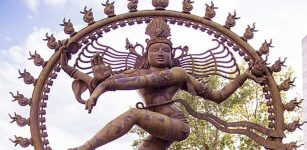 Shiva – Hindu God Who Resides In Every Being And In All Things
Featured Stories | Apr 8, 2019
Shiva – Hindu God Who Resides In Every Being And In All Things
Featured Stories | Apr 8, 2019 -
 Sir William Wallace: Brave Scottish Knight And Legendary Hero
Featured Stories | Feb 27, 2016
Sir William Wallace: Brave Scottish Knight And Legendary Hero
Featured Stories | Feb 27, 2016 -
 Huge Ancient Ceramic Workshop With Hundreds Of Stunning Artifacts Solves An Archaeological Mystery In Israel
Archaeology | Dec 14, 2020
Huge Ancient Ceramic Workshop With Hundreds Of Stunning Artifacts Solves An Archaeological Mystery In Israel
Archaeology | Dec 14, 2020 -
 On This Day In History: SS City of Glasgow Leaves Liverpool And Is Never Seen Again – On March 1, 1854
News | Mar 1, 2017
On This Day In History: SS City of Glasgow Leaves Liverpool And Is Never Seen Again – On March 1, 1854
News | Mar 1, 2017 -
 Secrets Of The Lost Ancient Sahara Civilization
Civilizations | Oct 26, 2018
Secrets Of The Lost Ancient Sahara Civilization
Civilizations | Oct 26, 2018 -
 Largest Viking-Age Building In Britain Has Been Found In Cumbria!
Archaeology | Feb 18, 2025
Largest Viking-Age Building In Britain Has Been Found In Cumbria!
Archaeology | Feb 18, 2025 -
 Scientists Attempt To Solve An Ancient Greek Volcano Mystery
Archaeology | Sep 20, 2022
Scientists Attempt To Solve An Ancient Greek Volcano Mystery
Archaeology | Sep 20, 2022 -
 Drones Find Evidence Roman Siege Of Masada Lasted Much Shorter Than Previously Thought
Archaeology | Sep 6, 2024
Drones Find Evidence Roman Siege Of Masada Lasted Much Shorter Than Previously Thought
Archaeology | Sep 6, 2024 -
 Encounter With Time Window At The Upper Current River And Curious Glimpses From The Past
Featured Stories | Jul 28, 2018
Encounter With Time Window At The Upper Current River And Curious Glimpses From The Past
Featured Stories | Jul 28, 2018 -
 Is The Puzzling Miami Circle Much Older Than Previously Thought?
Featured Stories | Mar 14, 2021
Is The Puzzling Miami Circle Much Older Than Previously Thought?
Featured Stories | Mar 14, 2021 -
 Bad King John’s Lost Treasure May Be Hidden Near The Walpole Marsh In The Fenlands – Archaeologists Say
Archaeology | Mar 27, 2024
Bad King John’s Lost Treasure May Be Hidden Near The Walpole Marsh In The Fenlands – Archaeologists Say
Archaeology | Mar 27, 2024 -
 Hulagu Khan Destroyed Thousands Of Priceless Ancient Books Kept In The House Of Wisdom In Baghdad
Ancient History Facts | Jun 21, 2018
Hulagu Khan Destroyed Thousands Of Priceless Ancient Books Kept In The House Of Wisdom In Baghdad
Ancient History Facts | Jun 21, 2018 -
 China’s 4,200-Year-Old Taosi Ruins Confirmed As Ancient Capital Of Legendary Emperor Yao
Civilizations | Sep 12, 2015
China’s 4,200-Year-Old Taosi Ruins Confirmed As Ancient Capital Of Legendary Emperor Yao
Civilizations | Sep 12, 2015 -
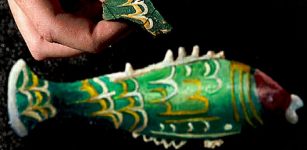 Rare 1,800-Year-Old Fragment From Fish-Shaped Roman Bottle Unearthed In Gloucestershire
Archaeology | Jul 23, 2019
Rare 1,800-Year-Old Fragment From Fish-Shaped Roman Bottle Unearthed In Gloucestershire
Archaeology | Jul 23, 2019 -
 Ancient Tomb Of William The Conqueror’s Nephew Discovered In Exeter
Archaeology | Aug 1, 2023
Ancient Tomb Of William The Conqueror’s Nephew Discovered In Exeter
Archaeology | Aug 1, 2023 -
 Unorthodox Ancient ‘Out-Of-This World’ Carvings Were Found And Destroyed – Mysterious Labyrinth And Unknown Ruins – Part 2
Ancient Mysteries | Aug 13, 2020
Unorthodox Ancient ‘Out-Of-This World’ Carvings Were Found And Destroyed – Mysterious Labyrinth And Unknown Ruins – Part 2
Ancient Mysteries | Aug 13, 2020 -
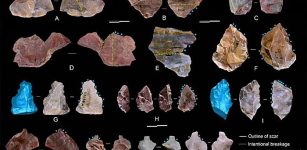 New Tool-Making Timeline For East Asian Hominins – Study
Archaeology | Mar 9, 2024
New Tool-Making Timeline For East Asian Hominins – Study
Archaeology | Mar 9, 2024 -
 On This Day In History: The Only English Pope In History Of Catholic Church Elected – On Dec 4, 1154
News | Dec 4, 2016
On This Day In History: The Only English Pope In History Of Catholic Church Elected – On Dec 4, 1154
News | Dec 4, 2016 -
 Lemko People – European Minority That Lost Their Homeland And Still Live In Exile
Civilizations | Jan 13, 2020
Lemko People – European Minority That Lost Their Homeland And Still Live In Exile
Civilizations | Jan 13, 2020

